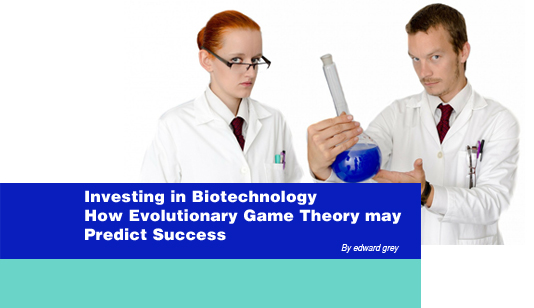Investing in Biotechnology:
How Evolutionary Game Theory may Predict Success
By Edward Grey – Capital Markets Editor
This article is written from an economic and capital market perspective. Terms like ‘Evolutionary Game Theory’, ‘Cooperation’, ‘Conflict’, and ‘Evolutionary Stable Strategy’ are used as economic terms of art to describe models of behaviour both past and future.
Selecting the right biotechnology company to invest in is not easy. There are a myriad of novel ideas and methodologies, few of which make it to the mainstream market. By understanding and applying the fundamental tenets of Evolutionary Game Theory (“EGT”) to selecting biotechnology investments, one may better predict which compounds and therapies may be more likely to succeed over the long-term.
Evolutionary Game Theory is a field within Economics that mathematically models behavior of organisms. Generally, each organism has embedded in its genetic code a ‘strategy’ for survival, and either co-evolves with other organisms through periods of ‘cooperation’ and ‘conflict’, or otherwise has an inferior strategy that eventually leads to its extinction. Periodically, organisms attain an Evolutionary Stable Strategy (ESS). An ESS is a strategy that if adopted by the populace is impervious to external conflict. However, with the myriad of competing organisms, such a strategy is often fleeting, at best.
Organisms may be as simple as protozoa and fungi, or as complex as some microbes (i.e., bacteria, viruses, and parasites) and humans. Certain microbes, such as some bacteria, exist in humans in an evolutionary stable state. However, other microbes, such as parasites, fungi, viruses, and foreign bacteria, challenge this stability through continuous conflict.
Strategies deployed by many microbes include both the genetic ability to rapidly evolve through reproduction, and to develop defenses against both antibiotics (i.e., antimicrobial resistance) developed by humans as well as the natural immune system of humans. This is particularly threatening to humans since the primary function of a microbe is to reproduce (i.e., perpetual conflict). While humans do not have a similar strategy embedded in their genetic code, they do have the strategic advantage of being able to think and manipulate their surroundings. This ability leads to what is termed ‘asymmetric information’, or one-sided information, against the microbes.
So, how does this understanding equate to better selecting biotechnology companies? The answer is to focus on biotechnology companies that have strategies to eradicate conflicts, instead of those that perpetuate conflict through cooperation and co-evolution. Considering the significant amount of capital required to develop and bring a drug to market, those companies that eradicate conflicts will likely yield greater success than those who address conflicts with near-term solutions that lead only to obsolescence.
For example, researchers at the University of East Anglia in the United Kingdom recently announced that they discovered both the path and gateway for how bacteria deliver their defensive coating to their outer surface. Further, they discovered that if this gateway is blocked, the bacteria die. This discovery will likely lead to new antibiotics that target the gateway to the bacteria’s defensive barrier. Current antibiotics go inside the bacteria (which is how the bacteria develop its antimicrobial resistance). It is this new class of antibiotics that would eradicate the ‘conflict’ instead of perpetuating a co-evolutionary existence of ‘cooperation’ and ‘conflict’. In turn, humans would have a momentary ‘evolutionary stable strategy’ to this particular conflict. For an investor, such an achievement would likely provide greater financial rewards.
An example of development-stage biotechnology companies that may not be as good of an investment are those that intend to design drugs to fit secondary, tertiary, and quadruple cancer mutations after the initial drug treatment. Similar to bacteria, cancers may mutate after receiving a threat to its existence by restructuring its protein. Several development-stage biotechnology companies have focused on addressing this conflict by redesigning these drugs to ‘fit’ into the newly mutated cancer protein. The problem with this type of company is that it will likely perpetuate the ‘conflict’. Specifically, it does nothing to address the cancer’s ability to mutate, and even with newly designed drugs it is likely to only experience continuous mutations albeit at a relatively lower rate. At no point is there an Evolutionary Stable Strategy. This, in turn, will create an even more expensive treatment process with the same likely outcome.
By applying the fundamental tenets of Evolutionary Game Theory, in particular ‘conflict’, ‘cooperation’, ‘co-evolution’, and ‘evolutionary stable strategy’, investors may better select biotechnology companies for investment. Specifically, they may best be suited to invest in companies that focus on eradication of the conflict, instead of those that effectively perpetuate the conflict in a constant state of co-evolution.
Edward Grey is Middle East Business Capital Markets Editor and a Managing Director at Watts Capital, LLC, a Manhattan, N.Y. based Wealth Management and Investment Banking firm. Mr. Grey advises both domestic and MENA region companies with a focus on biotechnology, genomics, and bioinformatics. Mr. Grey also serves as the Capital Markets Editor of the Middle East Business Magazine & News. Mr. Grey is a graduate of Carnegie Mellon University, where he received a Bachelors of Science for both Economics and Industrial Management, and Vermont Law School, where he received the Award of Academic Excellence for Law & Economics. Mr. Grey is also a Level II Candidate for the CFA designation.




























